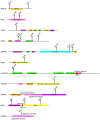Identification of ultra-rare genetic variants in pediatric acute onset neuropsychiatric syndrome (PANS) by exome and whole genome sequencing
- PMID: 35773312
- PMCID: PMC9246359
- DOI: 10.1038/s41598-022-15279-3
Identification of ultra-rare genetic variants in pediatric acute onset neuropsychiatric syndrome (PANS) by exome and whole genome sequencing
Abstract
Abrupt onset of severe neuropsychiatric symptoms including obsessive-compulsive disorder, tics, anxiety, mood swings, irritability, and restricted eating is described in children with Pediatric Acute-Onset Neuropsychiatric Syndrome (PANS). Symptom onset is often temporally associated with infections, suggesting an underlying autoimmune/autoinflammatory etiology, although direct evidence is often lacking. The pathological mechanisms are likely heterogeneous, but we hypothesize convergence on one or more biological pathways. Consequently, we conducted whole exome sequencing (WES) on a U.S. cohort of 386 cases, and whole genome sequencing (WGS) on ten cases from the European Union who were selected because of severe PANS. We focused on identifying potentially deleterious genetic variants that were de novo or ultra-rare (MAF) < 0.001. Candidate mutations were found in 11 genes (PPM1D, SGCE, PLCG2, NLRC4, CACNA1B, SHANK3, CHK2, GRIN2A, RAG1, GABRG2, and SYNGAP1) in 21 cases, which included two or more unrelated subjects with ultra-rare variants in four genes. These genes converge into two broad functional categories. One regulates peripheral immune responses and microglia (PPM1D, CHK2, NLRC4, RAG1, PLCG2). The other is expressed primarily at neuronal synapses (SHANK3, SYNGAP1, GRIN2A, GABRG2, CACNA1B, SGCE). Mutations in these neuronal genes are also described in autism spectrum disorder and myoclonus-dystonia. In fact, 12/21 cases developed PANS superimposed on a preexisting neurodevelopmental disorder. Genes in both categories are also highly expressed in the enteric nervous system and the choroid plexus. Thus, genetic variation in PANS candidate genes may function by disrupting peripheral and central immune functions, neurotransmission, and/or the blood-CSF/brain barriers following stressors such as infection.
© 2022. The Author(s).
Conflict of interest statement
The authors declare no competing interests.
Figures




References
-
- Frankovich, J. et al. The Burden of caring for a child or adolescent with pediatric acute-onset neuropsychiatric syndrome (PANS): An observational longitudinal study. J. Clin. Psychiatry80, 17m12091. 10.4088/JCP.17m12091 (2018). - PubMed
Publication types
MeSH terms
Substances
Supplementary concepts
Grants and funding
LinkOut - more resources
Full Text Sources
Medical
Miscellaneous

